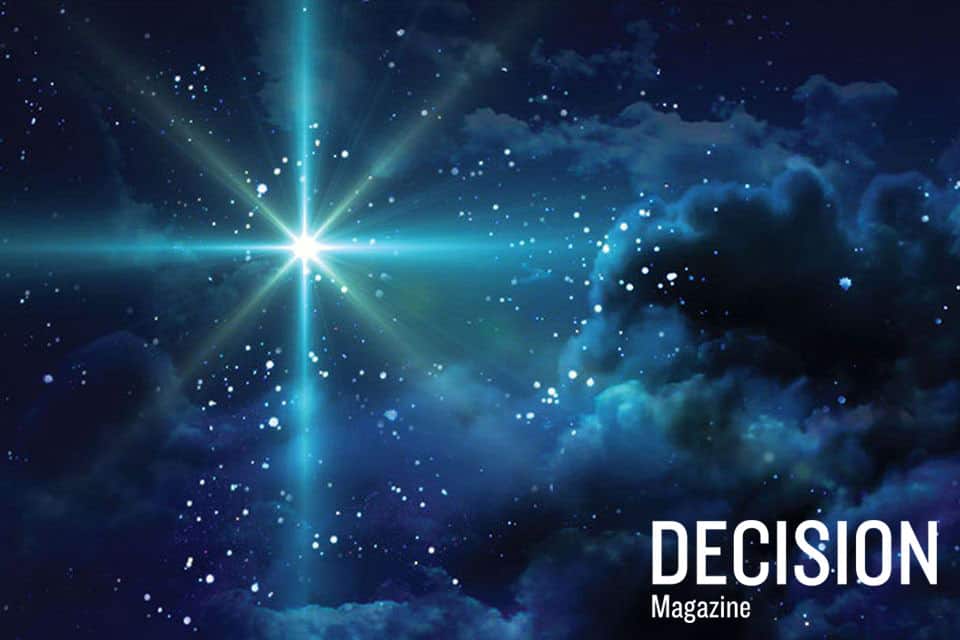
“I see him, but not now; I behold him, but not near. A star will come out of Jacob;
a scepter will rise out of Israel.” —Numbers 24:17, NIV
One of the issues raised in my book The Top 100 Questions relates to the Star of Bethlehem. How could it possibly be that the Eastern “Wise Men” of Matthew chapter 2 (the Magi) based their godly seeking of the infant king of the Jews upon astrology and divination by the stars? My questioner was asking how the Bible, which condemns occultism, could have accommodated this activity. What is the truth lying behind the Star of Bethlehem?
This was indeed a perceptive question. Vast reams—indeed whole books—have been devoted to this topic, which has captivated the interest of professors, scientists and such divines as Origen of Alexandria.
Subscribe to Decision
Get your own subscription, or renewal, or bless someone by giving Decision Magazine as a gift.
SUBSCRIBE NOW
No single theory has ever gained common acceptance. Great difficulties arise when we try to identify the Star of Bethlehem with some normal astronomical event—such as a conjunction of Jupiter and Halley’s Comet. On that level alone, the sheer difficulty of working out the GPS locations based on regular stellar patterns becomes all too apparent.
If the Star of Bethlehem was anything as mundane as that, it might indeed have interested these expert Gentile star-gazers (probably from the most ancient Chaldean school in Mesopotamia). But it would hardly have caused them to make a 300-mile journey to investigate further.
An astronomical occurrence—however unusual—would never by itself have told them that the unique, center-of-history Event had happened.
These wise men were not simpletons. Certainly they would not have benefited directly from the privileges of Judaism or its Scriptures. But it is very likely that they would have been familiar with a prophecy that had been uttered centuries earlier—by another Gentile like themselves—in this case Balaam by name.
Balaam—from Pethor, by the River Euphrates (Numbers 22:4-5)—was from their region. His words would have been remembered: “I see him, but not now; I behold him, but not near. A star will come out of Jacob; a scepter will rise out of Israel” (Numbers 24:17).
The star and scepter stood for regal power and splendor. Further lines in Balaam’s prophecy point to the widespread rule of this coming Person. Consequently, when a star came into view on a completely different and unique scale; miraculous—even to the point of earth-focused mobility—it awoke them to their remembrance of the prophecy and their reverence toward the coming King.
—Richard Bewes
“After Jesus was born in Bethlehem in Judea, during the time of King Herod, Magi from the east arrived in Jerusalem, asking, ‘Where is the One who has been born King of the Jews? We saw His star in the east [that is, when it rose in the east], and have come to worship Him’” (Matthew 2:1-2, Berean Study Bible).
Our starting point has to be that the birth of Jesus—and the star that heralded His coming—was the long-prophesied activity of God Himself. This has nothing to do with horoscopes or divination by the stars. Further, if we attempt to reduce the Star of Bethlehem down to a comet or a conjunction of planets, then we are never going to grasp the significance of what happened. How many of the Bethehem Star theorists—who looked so carefully into regular and normal stellar explanations—paused long enough to consider the obviously God-given and miraculous phenomena that invariably manifested at every other significant stage of Jesus’ saving work?
- The dove at His baptism.
- The transcendent light at His transfiguration.
- The midday darkness and earthquake at His death.
- The visible angels at His resurrection.
- The receiving cloud at His ascension.
- The flames and wind at the giving of the Spirit.
These occurrences attested Jesus as the Christ of God to those who had minds and the humility to take it in. Similarly, then, a star marked the birth of Jesus—in a way that manifestly had never happened before and would never happen again.
Sure, attempts can be made to “explain” the parting of the Red Sea at the time of Moses, or the whirling into Heaven of a fiery chariot at the time of Elijah, or the bodily raising of a corpse that could penetrate locked rooms … but all these ideas are missing the point. We are dealing with a Living God who governs the world just as He pleases. The laws of nature are, in reality, our human constructions as we attempt to map out the way that this Living God normally administers His created order.
Attempting these analyses on the Star of Bethlehem has attractions, but it is doomed to failure. Take in rather the attitude of the Magi. They were sensitive to given revelation from above. They were persistent in their search—to the very location. Although Herod’s religious advisors checked the prophecy of Micah 5:2—that Israel’s future Ruler would be from Bethlehem—none of them thought to make the seven-mile journey there. What identifies the Magi as the Wise Men was their supreme desire to worship the Child of the Manger.
Make it your resolve—this very Christmas! ©2016 Richard Bewes
Unless otherwise noted, Scripture quotations are taken from The Holy Bible, New International Version. The verses marked Berean Study Bible Are taken from The Holy Bible, Berean Study Bible, BSB, copyright ©2016 by Bible Hub. Used by permission. All rights reserved worldwide.
Give To Where Most Needed
